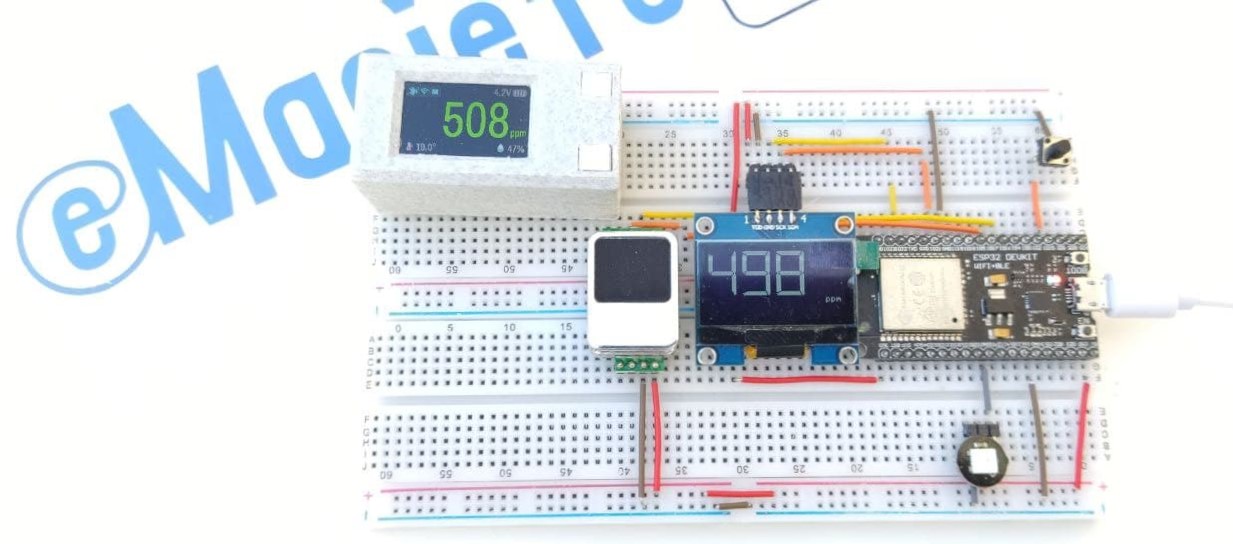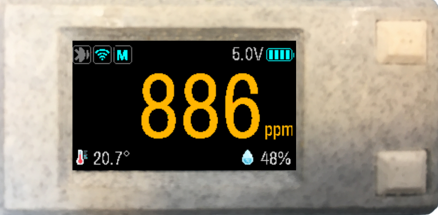| Don't forget to star ⭐ this repository |
An advanced fimware for CO2 Monitor/Meter. It's really flexible, you can use this firmware with any supported CO2 Monitor/Meter based on ESP32 (99,99% of them).
With cell phone App for real time visualization and charting of air quality data, datalogger, a variety of communication options (BLE, WIFI, MQTT, ESP-NOW) and many supported popular sensors.
This repository is mainly addressed at developers. If you are an end user willing to install and use the CO2 Gadget firmware, you will find complete instructions at my blog including instructions in how to install the firmware very easily, with just two clicks in your browser (without having edit files, compile or install anything on your computer).
If you don't have a CO2 Monitor you will also find some complete tutorials to build your own.
- Many popular CO2 sensors supported: Sensirion SCD30, Sensirion SCD4x (SCD40 and SCD41), Senseair S8 LP, Winsen MH-Z19 (A/B/C/D/E), Cubic CM1106
- Support for popular color and monochrome displays
- Fully functional without display (display not needed)
- Supports the Air Quality App Sensirion MyAmbiance for iOS and Android with real time visualization, charting and access to historycal data
- Real time visualization on display, serial port and web page
- Management and configuration via on screen menu, internal web page and console (USB/serial port)
- Local data logger with upload to phone by BLE
- WIFI connection
- Sending of data via MQTT
- Receiving remote commands via MQTT
- MQTT Discovery protocol for Home Assistant (and others supporting it as HomeSeer with mcsMQTT)
- Easy installing via web browser
- Easy WiFi setup via web browser on install and anytime (supports Improv-WiFi)
- Easy WiFi setup via bluetooth with the MyAmbiance App in iOS and Android
- ESP-NOW communications protocol from Espressif for long range and low power consuption (more info here)
- Over the air updates OTA
- Support for buzzer alarms on CO2 level
- Support for Neopixel (WS2812B) addressable LEDs (RGB, GBR and RGBW)
- Support for RGB LEDs
- GPIO outputs for alarms and activation of air circulation on CO2 concentration threshold with hysteresis. Check GPIO to use at my blog CO2 Gadget firmware page
This project support a large selection of ESP32 boards, displays and sensors.
As an example you can find a very detailed tutorial with step-by-step video on how to build a very compact CO2 Gadget with a TTGO T-Display board and a high quality Sensirion SCD30 dual channel NDIR CO2 sensor (and battery support) here.
For latest information on other hardware use (boards, sensors, displays, etc), please check options and GPIO to use at my blog CO2 Gadget firmware page
CO2 Gadget right now has support for many different OLED displays. There are precompiled versions for OLED I2C 1.3" 128x64 pixels display.

Supporting any other ESP32 board is very easy. Yoy just have to setup the pines accordly.
These are the GPIOs used by each predefined board:
| Flavor | Display | RX/TX | I2C SDA/SCL | UP/DWN | GPIO Orange | GPIO Red | GPIO Battery | GPIO Neopixel | GPIO Buzzer |
|---|---|---|---|---|---|---|---|---|---|
| TTGO_TDISPLAY TFT | TFT 240×135 | 13/12 | 21/22 | 35/0 | 32 | 33 | 34 | 26 | 2 |
| TTGO_TDISPLAY_SANDWICH | TFT 240×135 | 13/12 | 22/21 | 35/0 | 32 | 33 | 34 | 26 | 2 |
| TDISPLAY_S3 | TFT 320x170 | 18/17 | 43/44 | 14/0 | 03 | 01 | 04 | 16 | 2 |
| esp32dev_OLED SSH1106 | SSH1106 128×64 | 17/16 | 21/22 | 15/0 | 32 | 33 | 34 | 26 | 2 |
| esp32dev | No display | 17/16 | 21/22 | 15/0 | 32 | 33 | 34 | 26 | 2 |
| esp32dev-sandwich | No display | 17/16 | 22/21 | 15/0 | 32 | 33 | 34 | 26 | 2 |
| esp32dev-ST7789_240x320 | ST7789_240x320 | 17/16 | 21/22 | 19/0 | 32 | 33 | 34 | 26 | 2 |
- Flavour: Name of the firmware variant.
- Display: Display supported by each flavour.
- RX / TX: Pins (GPIO) used for sensors connected by serial port.
- I2C: Pins (GPIO) corresponding to the I2C bus for connection of I2C sensors and displays.
- UP / DWN: Pins (GPIO) to which to connect the "Up" and "Down" buttons. They are optional as CO2 Gadget is fully functional with no buttons attached.
- GPIO Orange: Pin (GPIO) corresponding to the output when the orange level is reached (for relays, alarms, and RGB LED).
- GPIO Red: Pin (GPIO) corresponding to the output when the orange level is reached (for relays, alarms, and RGB LED).
- GPIO Battery: Pin for battery voltage measurement.
- Neopixel GPIO: Pin to which you must connect the data line of the Neopixel (WS2812B) LEDs.
- Buzzer: Pin to connect a passive buzzer for CO2 level sound alarms (built in transistor recommended).
This project uses the CanAirIO sensorlib library to support as many sensors as possible out of the box. Thanks to @hpsaturn and CanAirIO team.
CanAirIO sensorlib right now supports:
| Sensor model | UART | I2C | Detection mode | Status |
|---|---|---|---|---|
| Honeywell HPMA115S0 | Yes | --- | Auto | DEPRECATED |
| Panasonic SN-GCJA5L | Yes | Yes | Auto | STABLE |
| Plantower models | Yes | --- | Auto | STABLE |
| Nova SDS011 | Yes | --- | Auto | STABLE |
| IKEA Vindriktning | Yes | --- | Select | STABLE |
| Sensirion SPS30 | Yes | Yes | Select / Auto | STABLE |
NOTE: Panasonic via UART in ESP8266 maybe needs select in detection
| Sensor model | UART | i2c | Detection mode | Status |
|---|---|---|---|---|
| Sensirion SCD30 | --- | Yes | Auto | STABLE |
| Sensirion SCD4x | --- | Yes | Auto | TESTING |
| MHZ19 | Yes | --- | Select | STABLE |
| CM1106 | Yes | --- | Select | STABLE |
| SenseAir S8 | Yes | --- | Select | STABLE |
| Sensor model | Protocol | Detection mode | Status |
|---|---|---|---|
| AM2320 | i2c | Auto | STABLE |
| SHT31 | i2c | Auto | STABLE |
| AHT10 | i2c | Auto | STABLE |
| BME280 | i2c | Auto | STABLE |
| BMP280 | i2c | Auto | STABLE |
| BME680 | i2c | Auto | STABLE |
| DfRobot SEN0469 NH3 | i2c | Auto | TESTING |
| DFRobot SEN0466 CO | i2c | Auto | TESTING |
| Geiger CAJOE | i2c | Select | TESTING |
| DHTxx | TwoWire | Auto | DEPRECATED |
NOTE: DHT22 is supported but is not recommended
Full details on CanAirIO sensorlib here
Note: If all you want is to install CO2 Gadget into your board go here:. You can install it from your web browser and don't need to compile the firmware.
You can use PlatfomIO CLI or VSCode with PlatformIO GUI (recomended). For installation see PlatformIO installation instructions:.
First you must edit the file platformio.ini to setup your preferences.
If necessary adjust the upload and monitoring port configuration to match your situation.
upload_speed = 921600
monitor_speed = 115200
upload_port = COM13
monitor_port = COM13
Save the file platformio.ini
I recommend PlatformIO because it is more easy than Arduino IDE. For this, please install first PlatformIO and its command line tools (Windows, MacOs and Linux), pio command, then connect your compatible board to the USB and run the next command:
pio run pio run -e TTGO_TDISPLAY_SANDWICH --target uploadYou must replace "TTGO_TDISPLAY_SANDWICH" with the flavour of CO2 Gadget you want compiled and uploaded (they are defined in platformio.ini or you can define your own).
If using PlatformIO GUI, to compile and upload CO2-Gadget into your board, press the "Alien head" -> Project tasks -> Choose flavour -> Upload and Monitor .
NOTE: Currently Arduino IDE is not supported. If you want to compile with the Arduino IDE, you will have to solve includes, dependencies and defines yourself.
I recommend that you use VS Code with PlatformIO. You have many tutorials on the internet, and it is not as difficult at all as it seems.
If you want to contribute to the code or documentation, consider posting a bug report, feature request or a pull request.
When creating a pull request, we recommend that you do the following:
- Clone the repository
- Create a new branch for your fix or feature. For example, git checkout -b fix/my-fix or git checkout -b feat/my-feature.
- Run to any clang formatter if it is a code, for example using the
vscodeformatter. We are using Google style. More info here - Document the PR description and code is a must
- Target your pull request to be merged with the
developmentbranch
- Implement full support for PM 2.5
- Everything about the Sensirion SCD30 NDIR dual-channel CO2 sensor
- Everything about the Sensirion SCD40 and the SCD41 RPAS CO2 sensors
- Everything about the Winsen MH-Z19 NDIR CO2 sensors
- Everything about the Winsen Low Consumption CO2 Sensor MH-Z1311A
- MH-Z19B vs Senseair S8 NDIR sensors
- Tutorial to build a CO2 Monitor with a TTGO T-Display board
Thanks to all collaborators, contributors and to the eMariete community for testing and reports.
Copyright (C) 2021-2024 CO2 Gadget Contributors
Contact: https://emariete.com
This file is part of the CO2 Gadget firmware.
The CO2 Gadget firmware is free software: you can
redistribute it and/or modify it under the terms of the GNU Lesser General
Public License as published by the Free Software Foundation, either version
3 of the License, or (at your option) any later version.
The emariete.com Website and Documentation is distributed in the hope
that it will be useful, but WITHOUT ANY WARRANTY; without even the implied
warranty of MERCHANTABILITY or FITNESS FOR A PARTICULAR PURPOSE. See the
GNU Lesser General Public License for more details.
You should have received a copy of the GNU Lesser General Public License
along with the emariete.com Website and Documentation. If not, see
<http://www.gnu.org/licenses/>.





